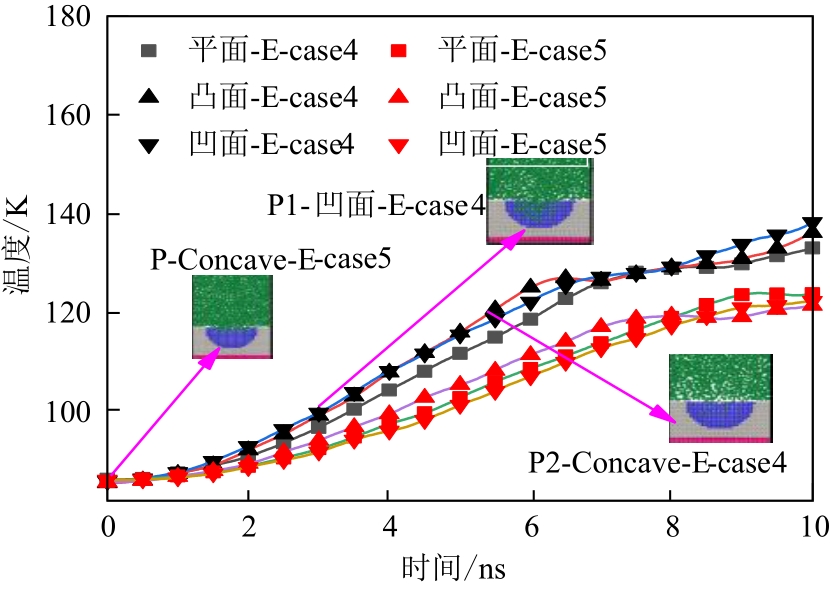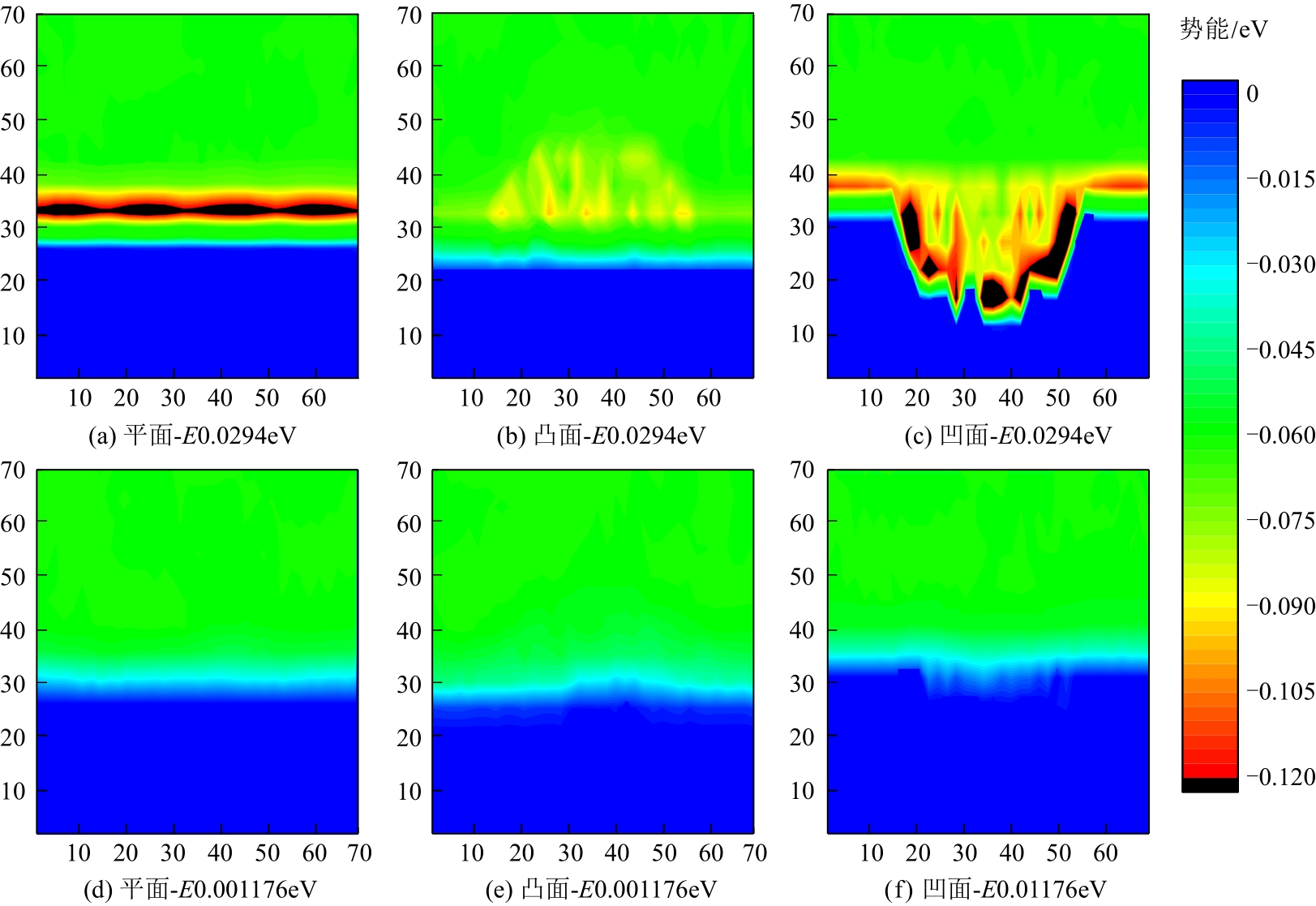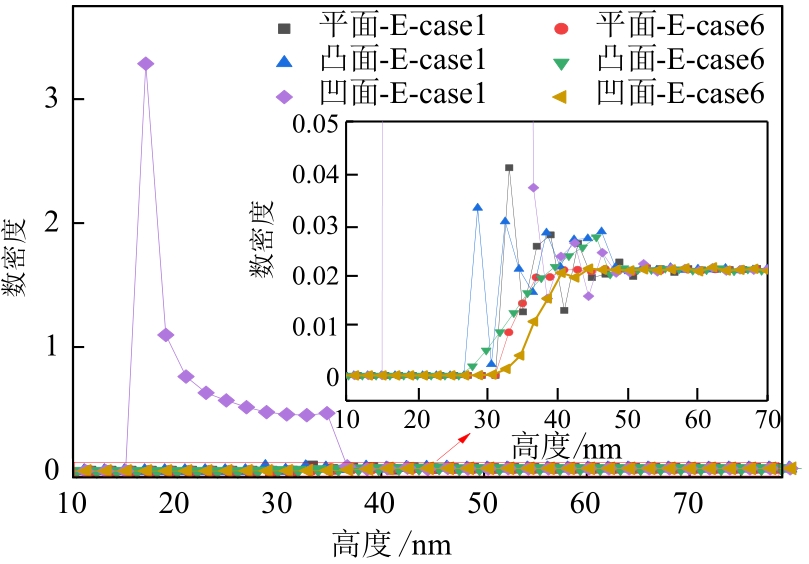Chemical Industry and Engineering Progress ›› 2022, Vol. 41 ›› Issue (5): 2311-2321.DOI: 10.16085/j.issn.1000-6613.2021-1175
• Chemical processes and equipment • Previous Articles Next Articles
Molecular dynamics simulation of liquid boiling on nanostructured surfaces
ZHANG Shizhong( ), CHEN Zhanxiu(
), CHEN Zhanxiu( ), LIU Fengrui, PANG Runyu, WANG Qing
), LIU Fengrui, PANG Runyu, WANG Qing
- School of Energy and Environmental Engineering, Hebei University of Technology, Tianjin 300401, China
-
Received:2021-06-02Revised:2021-12-20Online:2022-05-24Published:2022-05-05 -
Contact:CHEN Zhanxiu
纳米结构表面液体沸腾传热的分子动力学模拟
- 河北工业大学能源与环境工程学院,天津 300401
-
通讯作者:陈占秀 -
作者简介:张石重(1994—),男,硕士研究生,研究方向为强化传热及节能技术。E-mail:zhangszwork@qq.com 。 -
基金资助:河北省自然科学基金(E202102125)
CLC Number:
Cite this article
ZHANG Shizhong, CHEN Zhanxiu, LIU Fengrui, PANG Runyu, WANG Qing. Molecular dynamics simulation of liquid boiling on nanostructured surfaces[J]. Chemical Industry and Engineering Progress, 2022, 41(5): 2311-2321.
张石重, 陈占秀, 刘峰瑞, 庞润宇, 王清. 纳米结构表面液体沸腾传热的分子动力学模拟[J]. 化工进展, 2022, 41(5): 2311-2321.
share this article
Add to citation manager EndNote|Ris|BibTeX
URL: https://hgjz.cip.com.cn/EN/10.16085/j.issn.1000-6613.2021-1175
| 润湿壁面 | 势能参数/eV | 接触角/(°) |
|---|---|---|
| E-case1 | 0.029400 | 0 |
| E-case2 | 0.005880 | 48.95 |
| E-case3 | 0.004410 | 85.05 |
| E-case4 | 0.002940 | 122.62 |
| E-case5 | 0.002205 | 137.72 |
| E-case6 | 0.001470 | 170.79 |
| E-case7 | 0.001176 | 180.00 |
| 润湿壁面 | 势能参数/eV | 接触角/(°) |
|---|---|---|
| E-case1 | 0.029400 | 0 |
| E-case2 | 0.005880 | 48.95 |
| E-case3 | 0.004410 | 85.05 |
| E-case4 | 0.002940 | 122.62 |
| E-case5 | 0.002205 | 137.72 |
| E-case6 | 0.001470 | 170.79 |
| E-case7 | 0.001176 | 180.00 |
| 表面 | E-case1/ns | E-case2/ns | E-case3/ns | E-case4/ns | E-case5/ns | E-case6/ns | E-case7/ns |
|---|---|---|---|---|---|---|---|
| 平面 | 2.7 | 4.55 | 5.4 | 7.4 | 9.3 | 10.75 | 12.8 |
| 凸半球结构表面 | 2.25 | 3.91 | 4.6 | 6.35 | 7.425 | — | — |
| 凹半球结构表面 | 2.175 | 3.7 | 4.35 | 6.85 | 8.775 | 10.75 | — |
| 表面 | E-case1/ns | E-case2/ns | E-case3/ns | E-case4/ns | E-case5/ns | E-case6/ns | E-case7/ns |
|---|---|---|---|---|---|---|---|
| 平面 | 2.7 | 4.55 | 5.4 | 7.4 | 9.3 | 10.75 | 12.8 |
| 凸半球结构表面 | 2.25 | 3.91 | 4.6 | 6.35 | 7.425 | — | — |
| 凹半球结构表面 | 2.175 | 3.7 | 4.35 | 6.85 | 8.775 | 10.75 | — |
| 1 | MONTI R, BARBONI R, GASBARRI P, et al. Optimization and thermal control of a multi-layered structure for space electronic devices and thermal shielding of re-entry vehicles[J]. Acta Astronautica, 2012, 75(6): 42-50. |
| 2 | 臧徐忠, 石尔, 傅俊萍, 等.磁场调控磁性纳米流体流动和传热研究进展[J].化工进展,2019,38(12): 5410-5419. |
| ZANG Xuzhong, SHI Er, FU Junping, et al. A review of magnetic field effeets on flow and heat transfer in magnetic nanofluids[J].Chemical Industry and Engineering Progress, 2019, 38(12): 5410-5419. | |
| 3 | WU R K, HONG T, CHENG Q Y, et al. Thermal modeling and comparative analysis of jet impingement liquid cooling for high power electronics[J]. International Journal of Heat and Mass Transfer, 2019, 137: 42-51. |
| 4 | NAZARI M, MASOUDI A, JAFARI P, et al. Ultrahigh evaporative heat fluxes in nanoconfined geometries[J]. Langmuir, 2019, 35(1): 78-85. |
| 5 | RIOFRIO M C, CANEY N, GRUSS J A, et al. State of the art of efficient pumped two-phase flow cooling technologies[J]. Applied Thermal Engineering, 2016, 104: 333-343. |
| 6 | HUTTER C, KENNING D B R, SEFIANE K, et al. Experimental pool boiling investigations of FC-72 on silicon with artificial cavities and integrated temperature microsensors[J].Experimental Thermal and Fluid Science, 2010, 34(4): 422-433. |
| 7 | SIEDEL S, CIOULACHTJIAN S, BONJOUR J. Experimental analysis of bubble growth, departure and interactions during pool boiling on artificial nucleation sites [J]. Experimental Thermal and Fluid Science, 2008, 32(8): 1504-1511 |
| 8 | WANG H Y, LOU Q, LIANG H, et al. Numerical simulation of bubble dynamics and heat transfer in the 2D saturated pool boiling from a circular surface[J]. International Journal of Thermal Sciences, 2021, 170:107098. |
| 9 | 赵建福, 张良, 杜王芳, 等. 单气泡池沸腾传热中的重力效应数值模拟[J]. 空气动力学学报, 2021, 39(3): 121-129. |
| ZHAO J F, ZHANG L, DU W F, et al. Numerical simulation of gravity effect on heat transfer in single bubble pool boiling[J]. Acta Aerodynamica Sinica, 2021, 39(3): 121-129. | |
| 10 | 付婷. 金属表面微/纳结构设计制造及传质传热性能研究[D]. 广州: 华南理工大学, 2015. |
| FU T. Study on design &manufacture and heat and mass transfer performance of metal micro/nano structure[D]. Guangzhou: South China University of Technology, 2015. | |
| 11 | AHN H S, SATHYAMURTHI V, BANERJEE D. Pool boiling experiments on a nano-structured surface[J]. IEEE Transactions on Components and Packaging Technologies, 2009, 32(1): 156-165. |
| 12 | HENS A, AGARWAL R, BISWAS G. Nanoscale study of boiling and evaporation in a liquid Ar film on a Pt heater using molecular dynamics simulation[J]. International Journal of Heat and Mass Transfer, 2014, 71(1): 303-312. |
| 13 | MAO Y J, ZHANG Y W. Molecular dynamics simulation on rapid boiling of water on a hot copper plate[J]. Applied Thermal Engineering, 2014, 62(2): 607-612. |
| 14 | 王艳红, 王晓东. 液膜厚度和润湿性对汽化方式转变的影响[J]. 工程热物理学报, 2019, 40(10): 2395-2401. |
| WANG Y H, WANG X D. The effect of liquid film thickness and wettability on the transformation of vaporization[J]. Journal of Engineering Thermophysics, 2019, 40(10): 2395-2401. | |
| 15 | CHEN Y J, LI J F, BO Y, et al. Nanoscale study of bubble nucleation on a cavity substrate using molecular dynamics simulation[J]. Langmuir, 2018, 34(47): 14234-14248. |
| 16 | CHEN Y J, ZOU Y, SUN D L, et al. Molecular dynamics simulation of bubble nucleation on nanostructure surface[J]. International Journal of Heat and Mass Transfer, 2018, 118: 1143-1151. |
| 17 | DIAZ R, GUO Z X. Molecular dynamics study of wettability and pitch effects on maximum critical heat flux in evaporation and pool boiling heat transfer[J]. Numerical Heat Transfer, Part A: Applications, 2017, 72(12): 891-903. |
| 18 | LIU H Q, QIN X Y, AHMAD S, et al. Molecular dynamics study about the effects of random surface roughness on nanoscale boiling process[J]. International Journal of Heat and Mass Transfer, 2019, 145: 118799. |
| 19 | LIU R, LIU Z. Study of boiling heat transfer on concave hemispherical nanostructure surface with MD simulation[J]. International Journal of Heat and Mass Transfer, 2019, 143: 118534. |
| 20 | ZHANG L Y, XU J L, CHEN Q C, et al. Switchable heat transfer in nano Janus-interface-system[J]. International Journal of Heat and Mass Transfer, 2018, 127: 761-771. |
| 21 | MAROO S C, CHUNG J N. Molecular dynamic simulation of platinum heater and associated nano-scale liquid argon film evaporation and colloidal adsorption characteristics[J]. Journal of Colloid and Interface Science, 2008, 328(1): 134-146. |
| 22 | SHAVIK S M, HASAN M N, MORSHED A K M M. Molecular dynamics study on explosive boiling of thin liquid argon film on nanostructured surface under different wetting conditions[J]. Journal of Electronic Packaging, 2016, 138(1): 010904. |
| 23 | ALEXEEV D, CHEN J, WALTHER J H, et al. Kapitza resistance between few-layer graphene and water: liquid layering effects[J]. Nano Letters, 2015, 15(9): 5744-5749. |
| 24 | BOURDON B, RIOBOO R, MARENGO M, et al. Influence of the wettability on the boiling onset[J]. Langmuir, 2012, 28(2): 1618-1624. |
| [1] | HU Xi, WANG Mingshan, LI Enzhi, HUANG Siming, CHEN Junchen, GUO Bingshu, YU Bo, MA Zhiyuan, LI Xing. Research progress on preparation and sodium storage properties of tungsten disulfide composites [J]. Chemical Industry and Engineering Progress, 2023, 42(S1): 344-355. |
| [2] | XU Chunshu, YAO Qingda, LIANG Yongxian, ZHOU Hualong. Research progress on functionalization strategies of covalent organic frame materials and its adsorption properties for Hg(Ⅱ) and Cr(Ⅵ) [J]. Chemical Industry and Engineering Progress, 2023, 42(S1): 461-478. |
| [3] | XU Ruosi, TAN Wei. Flow field simulation and fluid-structure coupling analysis of C-tube pool boiling two-phase flow model [J]. Chemical Industry and Engineering Progress, 2023, 42(S1): 47-55. |
| [4] | XIAO Hui, ZHANG Xianjun, LAN Zhike, WANG Suhao, WANG Sheng. Advances in flow and heat transfer research of liquid metal flowing across tube bundles [J]. Chemical Industry and Engineering Progress, 2023, 42(S1): 10-20. |
| [5] | ZHAO Chen, MIAO Tianze, ZHANG Chaoyang, HONG Fangjun, WANG Dahai. Heat transfer characteristics of ethylene glycol aqueous solution in slit channel under negative pressure [J]. Chemical Industry and Engineering Progress, 2023, 42(S1): 148-157. |
| [6] | CHEN Lin, XU Peiyuan, ZHANG Xiaohui, CHEN Jie, XU Zhenjun, CHEN Jiaxiang, MI Xiaoguang, FENG Yongchang, MEI Deqing. Investigation on the LNG mixed refrigerant flow and heat transfer characteristics in coil-wounded heat exchanger (CWHE) system [J]. Chemical Industry and Engineering Progress, 2023, 42(9): 4496-4503. |
| [7] | ZHANG Fan, TAO Shaohui, CHEN Yushi, XIANG Shuguang. Initializing distillation column simulation based on the improved constant heat transport model [J]. Chemical Industry and Engineering Progress, 2023, 42(9): 4550-4558. |
| [8] | YIN Xinyu, PI Pihui, WEN Xiufang, QIAN Yu. Application of special wettability materials for anti-hydrate-nucleation and anti-hydrate-adhesion in oil and gas pipelines [J]. Chemical Industry and Engineering Progress, 2023, 42(8): 4076-4092. |
| [9] | BU Zhicheng, JIAO Bo, LIN Haihua, SUN Hongyuan. Review on computational fluid dynamics (CFD) simulation and advances in pulsating heat pipes [J]. Chemical Industry and Engineering Progress, 2023, 42(8): 4167-4181. |
| [10] | WANG Jiansheng, ZHANG Huipeng, LIU Xueling, FU Yuguo, ZHU Jianxiao. Analysis of flow and heat transfer characteristics in porous media reservoir [J]. Chemical Industry and Engineering Progress, 2023, 42(8): 4212-4220. |
| [11] | WANG Yungang, JIAO Jian, DENG Shifeng, ZHAO Qinxin, SHAO Huaishuang. Experimental analysis of condensation heat transfer and synergistic desulfurization [J]. Chemical Industry and Engineering Progress, 2023, 42(8): 4230-4237. |
| [12] | GUO Wenjie, ZHAI Yuling, CHEN Wenzhe, SHEN Xin, XING Ming. Analysis of convective heat transfer and thermo-economic performance of Al2O3-CuO/water hybrid nanofluids [J]. Chemical Industry and Engineering Progress, 2023, 42(5): 2315-2324. |
| [13] | LIU Houli, GU Zhonghao, YANG Kang, ZHANG Li. Effect of groove width on pool boiling heat transfer characteristics in 3D printing groove structure [J]. Chemical Industry and Engineering Progress, 2023, 42(5): 2282-2288. |
| [14] | ZHANG Chenyu, WANG Ning, XU Hongtao, LUO Zhuqing. Performance evaluation of the multiple layer latent heat thermal energy storage unit combined with nanoparticle for heat transfer enhancement [J]. Chemical Industry and Engineering Progress, 2023, 42(5): 2332-2342. |
| [15] | FU Shurong, WANG Lina, WANG Dongwei, LIU Rui, ZHANG Xiaohui, MA Zhanwei. Oxygen evolution cocatalyst enhancing the photoanode performances for photoelectrochemical water splitting [J]. Chemical Industry and Engineering Progress, 2023, 42(5): 2353-2370. |
| Viewed | ||||||
|
Full text |
|
|||||
|
Abstract |
|
|||||










